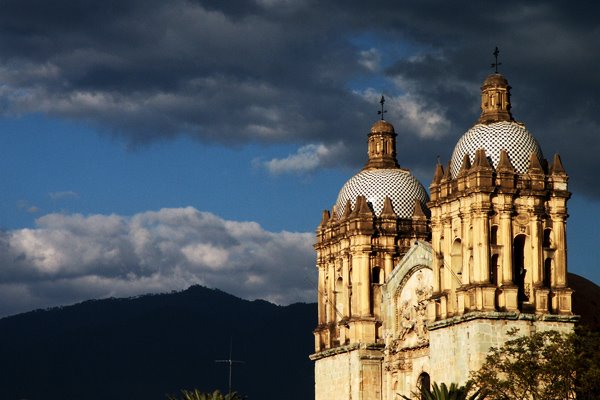
The artesanos of Oaxaca have been greatly affected by the political and economic problems. The area is renown for its rich and diverse art culture. As I mentioned earlier many of these villages prospered during the last thirty years as Oaxacan folk art was discovered by the rest of the world. I watched bridges, municipal centers, and schools being built using artistic income. People still worked in the campo or the fields,but they also capitalized on ever-widening fame and interest. It was not unusual to see Japanese or German television crews interviewing the artesanos in their homes. Large tour buses regularly came to the villages.
That ended when people stopped coming to Oaxaca. The disruptions, protests, marches, barricades and ultimately, the violence and death were international news and tourism fell off 95 percent.Money stopped coming in. Money or the lack of money is always one of the major influences in how people think.
If you had a business, a restaurant, hotel or tour service, how long could you hang on if you had no income?
And if you were an artesano who no longer had visitors, customers, what would you do?
You might stop making as much or as many. You might stop altogether.
The three main pueblos for woodcarving are San Martin Tilcajete, Arrazola and La Union Tejalapam and the plan for the next few weeks is to make directories of all the artesanos in each village. Normally, it is like everywhere, it is who you know and how you get there that makes all the difference. Everyone has their favorite or a family connection. So each taxista will take you to their guy. They get a commission, too.
If I took you to the carving villages, I would take you to my favorites and I even have gotten commissions in the past, always a carving slipped to me as a gift as i was leaving. Of course, I take people to my people because I love them and their work. They are magical artists and I have been learning from them for years.
So the directories will have ALL the artesanos, not just favorites, listed with an address, phone number (if one exists) and a photo of the artist.
It is more complicated than it might appear. The nature of the carving business has changed. The work sometimes comes through sub-contractors. Someone supplies blancos or unpainted white figures, then someone else paints them and then finally, someone else signs it. I have seen it many times and always try to know who carved the piece and who painted it. I request certain carvers and can spot their work instantly. I am particularly careful about who paints it. Someone like Maria Jimenez of San Martin is recognized as one of the best. There are others who are equally talented. And it runs in families
The directories will include individuals or families who do all or most of the work.
Yesterday it was La Union, which is about an hour west from San Agustin. La Union is set on a series of hillocks with no real town center. I drove there at mid morning and got an eyeful of the color of southern rural Mexico. The countryside is lush and green with corn and various crops. It has been a great rainy season. I don't remember seeing things this lush before. As I drove through several villages and across a fertile valley into the hills, there were horse drawn carts and teams of oxen with yokes and plows.
A slightly different commute to work experience from Boston or St. Thomas.
The directories cannot be created without cooperation from the pueblos and the artesanos themselves. I know that it is key for me to have someone from the village to help and to introduce me. With my partner, Abigail Mejia, who lives in La Union, we drove, backtracked, or walked to every artesano in the pueblo. We hiked through arroyos and crossed creeks from house to house at different times in the day. Some of the houses were way of the beaten track with no phone or electricity in sight.
Abby did most of the talking and explained what we were trying to do. Everyone was very gracious and we ended a long day with all or most of the information we needed to put the directory together. We have photos of all the artesanos except one or two, who weren't home. We will get them next week.
The pictures speak to what a rare day it was. It was fascinating to visit all of these people in their homes, an insightful experience, a privilege .
The directory for La Union should be done shortly.
Next, San Martin Tilcajete.
photos l to r
Octavio Santiago Lopez, Rodrigo Cruz Almogabar and family,
Francisco Santiago Cruz, Avelino Perez Muños,
Maximino Santiago Lopez and Yolanda, Martin Santiago Cruz,
Calixto Santiago Lopez, Alberto Perez Muños,
Placido Santiago Cruz, and a future artesano.






















